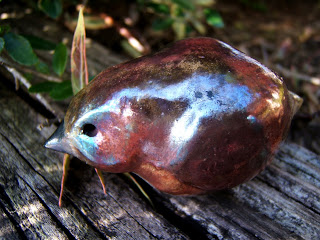So I've been really getting immersed into my raku firing. I started out with
Amaco Raku Glazes and I do like them, but I'm really excited about my new
Spectrum Raku Glazes . I do my raku firing on a very small scale, I have a small kiln about 8 inches by 8 inches. My "receptacle" is a repurposed metal pot with lid. My "organic material" of choice has been by far to be newspaper, newsprint-not the colored ads. From my own tests and experiences I have learned this :
- don't allow a lot of open space inside the "receptacle"
- newspaper is superior because it readily ignites and doesn't mar the surface as much
- allowing the item to sit in the flames with the can open has produced more dramatic color effects and thicker smoke which helps blacken unglazed surfaces better
- always use the recommended three coats of raku glaze for best results.
- Stoneware clay makes an excellent raku clay
Of course, this is my own personal observation, but since I've been following this, I've had better results with my pieces.
Spectrum Gator Skin is my new favorite. If anyone is just starting out and only buying one color, this is the one I recommend. Applied thin, it gives an almost dappled streaky copper look. Applied thick, it looks very much like the sample picture. It is a gorgeous matte color. With a thick application it gets nice and crusty. It's a more expensive color but very well worth it in my opinion.
This picture is good for showing the glaze in thick and thinner applications. Applied thinner it is more earthy and dappled brown.
The pendant above has the "gator skin" put into the grooves of the heart. Then I put 3 coats of Amaco white raku glaze. They seem to react very nice together, developing a warm silvery ivory to shades of copper.
Spectrum Nebula is another shade that I purchased. This one is a bit trickier to work with, but I think I've discovered a trick. Without enough time in the flame, "Nebula" is kind of a flat aqua shade, but if you give it enough time in the flame, it becomes very worthy of it's name. What I ended up with was :
Blues, reds, and copper colors mainly. It can produce a pretty rainbow effect.
Another color I purchased was
Spectrum Cobalt . So far I've gotten a few different results. None quite like the picture shown when I ordered it, but still very attractive. I've gotten a deep slightly transparent blue, and with optimal conditions a lot of silvery metallic as well.
This is the cobalt. I used the gator skin for the beak, a very thin coat (produces a pretty rusty color). I also rubbed some of the gator skin into the letters. When the two react, I've gotten a bit of a golden hue surrounding.
This is what happens if there is not enough reduction going on in the "receptacle"
Still a pretty color, but not very dramatic.
I still like my Amaco raku glazes quite a bit. My favorite colors are white:
Copper Patina:
and Bluebell:
Hoping this helps anyone looking for some visual examples of some of the glazes out there. Please feel free to message me if you have any questions about any of my experiences with these colors.
















